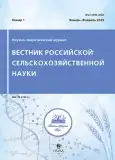Оптимизация элементов методики клонального микроразмножения смородины красной (Ribes rubrum L.) с учетом генотипических особенностей
- Авторы: Ряго Н.В.1, Хромова Т.М.1, Ташматова Л.В.1
-
Учреждения:
- Всероссийский научно-исследовательский институт селекции плодовых культур
- Выпуск: № 1 (2025)
- Страницы: 24-29
- Раздел: Растениеводство и селекция
- URL: https://journal-vniispk.ru/2500-2082/article/view/286048
- DOI: https://doi.org/10.31857/S2500208225010057
- EDN: https://elibrary.ru/CTZWCM
- ID: 286048
Цитировать
Аннотация
В статье рассмотрена эффективность микроклонального размножения смородины красной в зависимости от срока изоляции меристем, генотипических особенностей сортов и органического состава питательной среды на различных этапах культивирования. Исследования проводили в 2022–2023 годах на базе лаборатории биотехнологии ФГБНУ ВНИИСПК. Объект изучения – сорта селекции ВНИИСПК (Валентиновка, Вика, Газель). Изоляцию меристем осуществляли в два периода – апрель и июнь. Испытаны три среды на основе макро- и микросолей Murashige – Skoog с добавлением 0,2 мг/л 6-БАП, 10 мг/л аскорбиновой кислоты, тройного содержания хелата железа и разного содержания витаминов: 1) B1 (0,5 мг/л), B6 (0,5 мг/л), PP (0,5 мг/л) (контроль, MS); 2) B1 (0,1 мг/л), B6 (0,5 мг/л), PP (0,5 мг/л) (MS1); 3) B1 (10,0 мг/л), B6 (10,0 мг/л), PP (5,0 мг/л) (MS2). Наиболее существенное влияние на результат введения в культуру in vitro оказали сроки изоляции эксплантов и соответствующие им климатические условия, а также генотипические особенности сортов. Более высокую приживаемость при введении в апреле имели экспланты сортов Газель и Вика. Летний период введения для всех изучаемых сортов характеризовался ростом доли некроза и заражения эксплантов, вплоть до их гибели (Валентиновка). Изменение концентрации витаминов несущественно помогало приживаемости эксплантов на этапе инициации в культуре in vitro, культивированию микрорастений смородины красной на питательных средах, содержащих 6-БАП 0,8 мг/л (MS3) и 6-БАП 0,5 мг/л, ИМК 0,1мг/л, ГК 0,1мг/л (MS4) – на коэффициент размножения. Добавление в состав питательной среды низких концентраций цитокининов, ауксинов и гибберелловой кислоты способствовало увеличению высоты микропобегов смородины красной Газель.
Ключевые слова
Полный текст
Об авторах
Нелли Васильевна Ряго
Всероссийский научно-исследовательский институт селекции плодовых культур
Автор, ответственный за переписку.
Email: ryago@orel.vniispk.ru
аспирант
Россия, д. Жилина, Орловская обл.Татьяна Михайловна Хромова
Всероссийский научно-исследовательский институт селекции плодовых культур
Email: ryago@orel.vniispk.ru
кандидат биологических наук
Россия, д. Жилина, Орловская обл.Лариса Владимировна Ташматова
Всероссийский научно-исследовательский институт селекции плодовых культур
Email: ryago@orel.vniispk.ru
кандидат сельскохозяйственных наук
Россия, д. Жилина, Орловская обл.Список литературы
- Бунцевич Л.Л., Беседина Е.Н., Костюк М.А., Макаркина М.В. Разработка составов питательных сред для интродукции в культуру in vitro эксплантов сортов малины и крыжовника // Плодоводство и виноградарство юга России. 2014. № 28(04). С. 46–55.
- Гусева К.Ю. Клональное микроразмножение смородины черной (Ribes nigrum L.) // Проблемы ботаники Южной Сибири и Монголии. 2020. № 19 (2). С. 5–10. https://doi.org/10.14258/pbssm.2020064
- Джигадло Е.Н., Джигадло М.И., Голышкина Л.В. Методические рекомендации по использованию биотехнологических методов в работе с плодовыми, ягодными и декоративными культурами. Орел: ВНИИСПК, 2005. 51 с.
- Доспехов Б.А. Методика полевого опыта (с основами статистической обработки результатов исследований) // М.: Агропромиздат, 1985. 351 с.
- Кузьмина Т.И., Кузнецова А.П., Федорович С.В. Повышение экономической эффективности клонального микроразмножения плодовых культур путём оптимизации периода интродукции in vitro эксплантов // Вестник Университета Российской академии образования. 2020. № 5. С. 51–58.
- Кухарчик Н.В., Кастрицкая М.С., Семенас С.Э. и др. Размножение плодовых и ягодных растений в культуре in vitro. Минск: Беларуская навука, 2016. 208 с.
- Тимофеева С.Н., Смолькина Ю.В., Апанасова Н.В., Юдакова О.И. Технологии микроразмножения in vitro: учебно-методическое пособие. Саратов: СГУ имени Н.Г. Чернышевского, 2016. 38 с.
- Усков А.И. Воспроизводство оздоровленного исходного материала для семеноводства картофеля: 3. Размножение исходных растений // Достижения науки и техники АПК. 2009. № 12. С. 17–20.
- Хромова Т.М., Ташматова Л.В., Мацнева О.В., Шахов В.В. Некоторые аспекты введения в культуру in vitro сортов смородины черной селекции ВНИИСПК // Вестник аграрной науки. 2020. № 4 (85). С. 31–36.
- Шахов В.В., Ташматова Л.В., Мацнева О.В. Сравнительная характеристика сроков введения эксплантов черной смородины (Ribes nigrum L.) в культуру in vitro // Современное садоводство. 2017. № 4 (24). С. 102–105.
- Abrahamian P., Kantharajah A. Effect of vitamins on in vitro organogenesis of plant // American journal of plant Sciences. 2011. Vol. 2. No. 05. P. 669–674. https://doi.org/10.4236/ajps.2011.25080
- Asensi-Fabado M.A., Munné-Bosch S. Vitamins in plants: occurrence, biosynthesis and antioxidant function // Trends in plant science. 2010. Vol. 15. No. 10. P. 582–592. https://doi.org/10.1016/j.tplants.2010.07.003
- Boubakri H., Gargouri M., Mliki A. et al. Vitamins for enhancing plant resistance // Planta. 2016. Vol. 244. P. 529–543. https://doi.org/10.1007/s00425-016-2552-0
- Cárdenas M. J.S. Adaptación de protocolos de establecimiento in vitro de Ribes rubrum L., Ribes nigrum L. y Ribes uva-crispa L. Doctoral dissertation. Valdivia: Universidad Austral de Chile, 2016. 41 p.
- Dziedzic E., Jagła J. Micropropagation of Rubus and Ribes spp. // Protocols for Micropropagation of Selected Economically-Important Horticultural Plants. 2013. P. 149–160. https://doi.org/10.1007/978-1-62703-074-8_11
- George E.F., Hall M.A., Klerk G.J.D. The components of plant tissue culture media II: organic additions, osmotic and pH effects, and support systems. In Plant propagation by tissue culture: vol. 1. The background. Dordrecht: Springer Netherlands, 2008. P. 115–173.
- Isroilova S.J. Особенности микроклонального размножения плодовых культур в условиях in vitro // Theoretical & Applied Science. 2019. No. 5 (73). С. 531–535.
- Pitzschke A., Fraundorfer A., Guggemos M., Fuchs N. Antioxidative responses during germination in quinoa grown in vitamin B-rich medium // Food Science & Nutrition. 2015. Vol. 3. No. 3. P. 242–251. https://doi.org/ 10.1002/fsn3.211
- Ryago N.V. Features of micro clone reproduction of some currant representatives of the genus Ribes spp.: review // Agrarian Bulletin of the Urals. 2023. Vol. 23. No. 10. P. 69–80. https://doi.org/10.32417/1997-4868-2023-23-10-69-80
- Smith A.G., Croft M.T., Moulin M., Webb M.E. Plants need their vitamins too // Current opinion in plant biology. 2007. Vol. 10. No. 3. P. 266–275. https://doi.org/10.1016/j.pbi.2007.04.009
Дополнительные файлы












